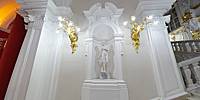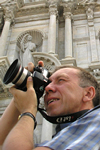
The Jordan Staircase
The Winter Palace, Saint Petersburg, Russia
January 31, 2018 - 17:56 local time
© 2018 Andrew Varlamov, All Rights Reserved.
In 2017, to mark the 100th anniversary of the Russian Revolution, the State Hermitage has prepared a major project under the general title “The Storming of the Winter Palace”. The central event of the project became the exhibition “The Winter Palace and the Hermitage in 1917. History was made here”, the formal opening of which was taking place on 25 October 2017.
The year 1917 swept across Russia, bringing turmoil to the life of the huge country. The February Revolution and the abdication of Emperor Nicholas II, followed by Grand Duke Mikhail Alexandrovich’s non-acceptance of supreme power, put an end to the monarchy. The October Revolution ushered in a new era in world history. Events unfolded in the very centre of the capital – in the Winter Palace. Even converted into a huge military hospital, it remained a symbol of imperial rule. That is why it was here that the revolutionary masses gathered in February 1917 and right here that the Provisional Government was arrested in October 1917.
The events of 1917 also affected the Hermitage, which experienced in full measure all the cataclysms of that time. The museum’s curators protected the treasures entrusted to them. They kept watch in the museum round the clock as there were not enough guards, oversaw the evacuation of the collections and refused to allow exhibits to be taken from the museum to suit the political ends of the new Bolshevik rulers. Most importantly, they began to implement the idea of turning a court museum into a national one. The Hermitage’s main “revolutionary achievement” was the joining of the Winter Palace to the museum: Imperial Hermitage and imperial residence were united in one of the world’s greatest museums. ...
On 1 August (19 July Old Style) 1914, Germany declared war on Russia. The following day the Emperor had a prayer service held in the Nicholas Hall. On Palace Square a great crowd of ordinary people kneeled while listening to the Emperor’s speech about the declaration of war. In 1915 Nicholas II took the decision to assume personal command of the Russian forces. In leaving the capital for the front, he committed a tragic error. By 1917 he had completely lost control over the situation in Petrograd, as the city had been renamed, where dissatisfaction with the protracted war intensified and public unrest began to grow. By that time, patriotic determination to see the great struggle through to victory had given way to the slogan “Down with the war!”
For the imperial family the war was a personal cause. Both Empresses, Nicholas II’s elder daughters and other members of the imperial family organized military hospitals and hospital trains, where they also worked themselves. “One so much wants to comfort and support these brave men and to stand in for their loved ones who are unable to be beside them!” Alexandra Feodorovna wrote to her husband, the Emperor, in March 1915. Part of the display will be devoted to the Military Hospital named after the Heir and Tsesarevich Alexei that was opened in the Winter Palace in 1915 and functioned until 27 October 1917. The 1000-bed hospital was intended only for badly wounded soldiers. All the state rooms except the St George Hall were given over to it. The decorations were removed from the halls and the floors were covered with linoleum. The staff of the hospital under head physician Alexander Rutkovsky consisted of 24 doctors, 50 nurses and 120 medical orderlies.
Operations of the most difficult kinds were carried out here, including brain surgery. ...
On 23 February (8 March) 1917, meetings against the war devoted to the Day of Working Women, spontaneously flared up into mass strikes and demonstrations. On 27 February the armed forces began to mutiny: soldiers of the Life Guards Volhynia Regiment refused to obey government orders to fire on demonstrators. On 1 March the Petrograd garrison went over to the side of the strikers. The insurgents stormed and ransacked police stations and the city’s prisons, releasing the inmates, criminals as well as political detainees. Badly informed by contradictory reports from the capital, Nicholas II only left army headquarters in Mogilev for Petrograd on 1 March, but the imperial train was halted at Pskov on the orders of the hastily formed Provisional Committee of the State Duma. On 2 March, on the initiative of, and under pressure from, the Duma and the army high command, Emperor Nicholas II signed the Act of Abdication from the Russian throne.
On 2 (15) March 1917, the Provisional Committee of the State Duma and the Executive Committee of the Petrograd Soviet of Workers’ and Soldiers’ Deputies formed the Provisional All-Russian Government with eleven members, headed by Prince Georgy Lvov. The chief task of the Provisional Government was to summon a Constituent Assembly that would decide the future system of government for the country. The composition of the government changed several times. On 8 July 1917, after Prince Lvov’s resignation, Alexander Kerensky became prime minister. He moved into the Winter Palace together with his staff and a bodyguard of officer cadets.
On the night of 25 October (7 November) 1917, Vladimir Antonov-Ovseyenko, the secretary of the Petrograd Military Revolutionary Committee, and a group of soldiers and sailors arrested members of the Provisional Government in the Small Dining-Room of the Winter Palace. They entered the palace unobstructed since by that time the bulk of those defending the government had left the building. Only a part of the Women's Battalion of Death and a few cadets outside the Small Dining-Room were prepared to defend the government to the last, but the ministers decided to avoid bloodshed and ordered them to stop resisting. The October seizure of power was over. A commemorative display devoted to the arrest of the Provisional Government in the early hours of 26 October 1917 will be installed in the Small Dining-Room.
On 9 March 1917, immediately on rejoining his family in Tsarskoye Selo, the former Emperor was placed under house arrest, just as General Lavr Kornilov had arrested Alexandra Feodorovna the day before. In the summer of 1917 the Provisional Government moved the whole family to Tobolsk in Siberia. After October, the question of “bringing Nikolai Romanov to Petrograd and putting him on trial” was repeatedly raised at meetings of the Council of People’s Commissars, the new Bolshevik government. It was, however, decided for the moment to move the family “to a more reliable place”. In late April 1918, the Romanovs were transported to Yekaterinburg in the Urals, where they were held in the house of the engineer Ipatyev. There, in the early hours of 17 July 1918, Emperor Nicholas II, Empress Alexandra Feodorovna, Grand Duchesses Olga, Tatiana, Maria and Anastasia, and the Heir and Tsesarevich Alexei were all shot. ...
During the February Revolution, the Hermitage was closed to the public. The revolution and Nicholas II’s abdication were received enthusiastically in the museum. The Hermitage staff did not, however, accept the October Revolution, regarding the new authorities as usurpatory. Count Dmitry Tolstoi, who was director of the museum from 1909 to 1918, recalled: “One might say that at that time the whole Hermitage lived a difficult, feverish existence. It seemed as if you were experiencing a nightmare or burying someone very dear and close to you…”
Sources for home reading:
- The Cambridge History of Russia, volume 3.The Twentieth Century,
- "The Winter Palace and the Hermitage in 1917. History was made here", Official press release of the State Hermitage Museum, October 2017
Lat: 59° 56' 28.289" N
Long: 30° 18' 49.952" E
Precision is: Medium. Nearby, but not to the last decimal.
Camera: Pentax K-5 II; Lens: Samyang 8mm f/3.5 UMC Fish-eye CS II; Hot shoe two axis double bubble spirit level: ROWI 197;Cable switch: CS-205; Shooting without tripod manual by Nuno A. Madeira (Portugal); PC Software: PTGui Pro 10.0.15 by New House Internet Services B.V. (dated by January 5, 2016),Pano2QTVR Pro Flash version 1.6.6 by Thomas Rauscher
When I took shots for these panoramas at end of January 2018, the theme of the next WWP event was not proclaimed yet. Without long-expected return of Markus, its publication would be impossible.
Long hallway with European tapestries (hall № 303) leads from entrance on the square side to Rotunda, and it is decorated by red banners with revolutionary slogans.
Rotunda (hall № 156) displays posters, newspapers and magazines printed in 1917-1920. The Small Dining-Room (hall № 188) (where the Provisional Government was arrested by the Bolsheviks in 1917) is one of the next rooms.
In the Jordan Gallery (or Rastrelli Gallery) on the ground floor artistic lighting is installed, walls and pillars of the gallery are mantled by large reproductions and red banners of 100 years's prescription.
To feel the difference please check how the gallery looks usually


 Tap or click the zoom icon in the bottom right corner of the picture to switch between in-page and fullscreen view
Tap or click the zoom icon in the bottom right corner of the picture to switch between in-page and fullscreen view